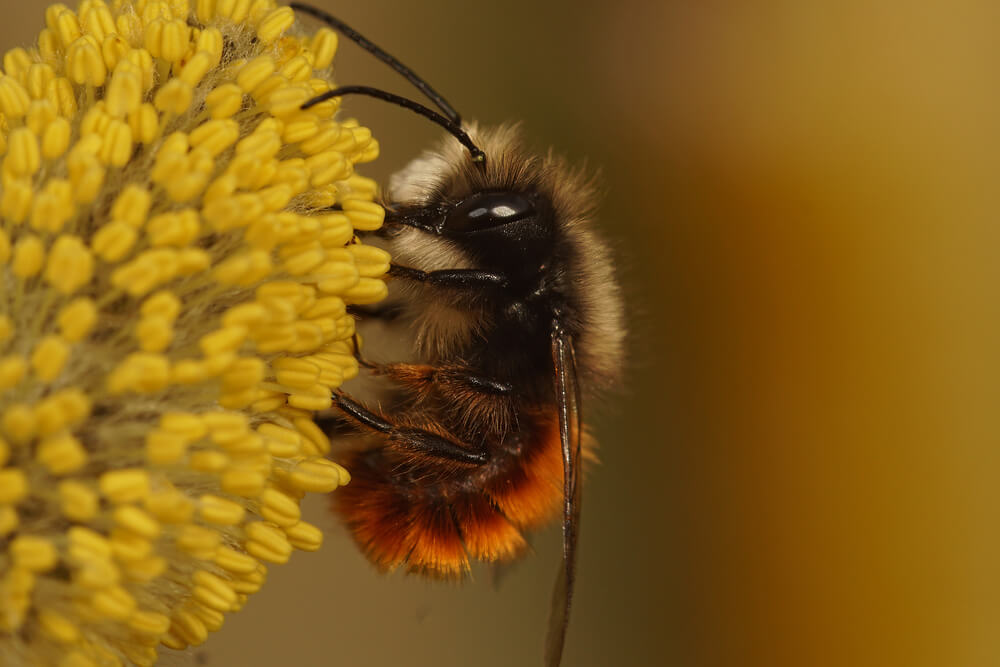Are Mason Bee Houses Good?
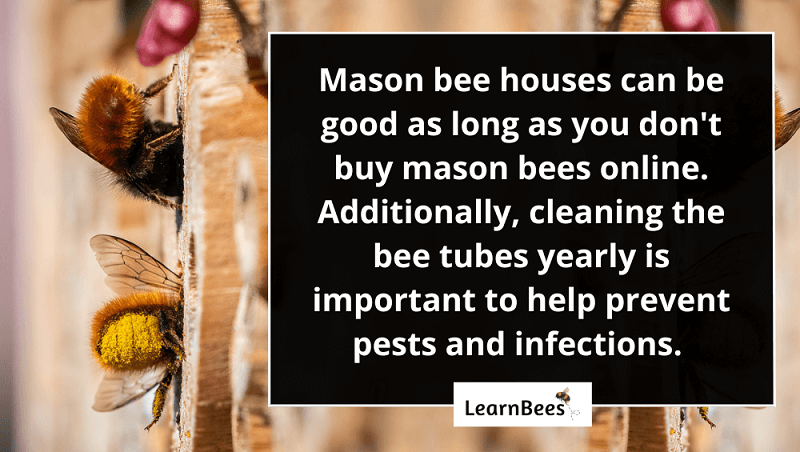
It’s the million-dollar question…
Are mason bee houses good or bad?
Mason bee houses can be good for your local bees. Not only that, but planting more flowers and using fewer pesticides creates a healthy ecosystem for all your native pollinators to thrive in.
And just as important?
Bees need a nearby water source to drink from.
Since bees can’t swim, they require landing perches like rocks or marbles to rest on safely while they drink. Filling a shallow birdbath with rocks that sit above water level will do the trick.
The bottom line?
Planting native flowers, quitting pesticides, and adding a safe water resource will go a long way in attracting local bees to your mason bee house.
But there’s something you should know first:
Never buy mason bees online.
Mason bee housing should only be installed to attract your local mason bees. You should never buy mason bees – or any bee, for that matter – online.
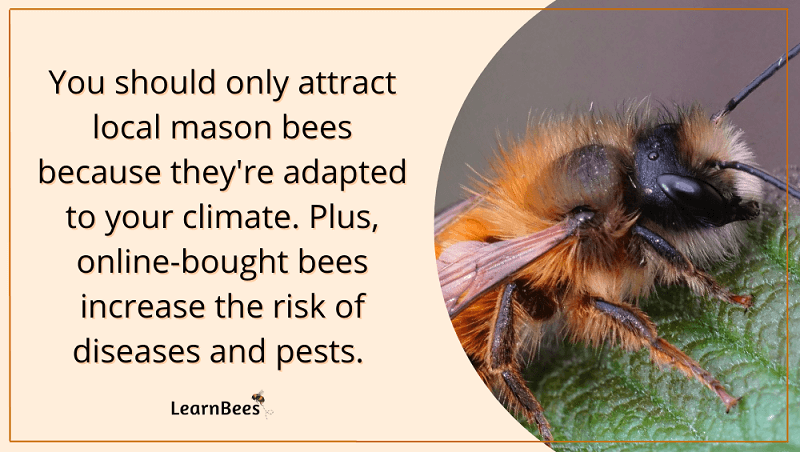
Instead, you want mason bees already adapted to your local climate. Shipping mason bees around the country forces them to live where they’re poorly suited. For example, mason bees shipped from a cool, wet climate likely will not thrive if sent to a hot, dry climate.
Worse yet?
Transporting bees around the country also ships diseases and parasites along with them. The infections from these bees can wreak havoc on your local ecosystem.
Not to mention:
Mason bee cocoons that are bought online are extracted, washed, bleached, refrigerated, stored, and shipped. This is hardly natural, and yet, the idea that this is “saving the bees” persists.
So, what should you do?
Put a mason bee house out, plant native flowers, provide water, and avoid using pesticides.
The mason bees may not come in the first year, but they will come soon enough. And they’ll be healthier mason bees with far fewer pests and diseases.
Patience is the key.
Instructions for Mason Bee Housing
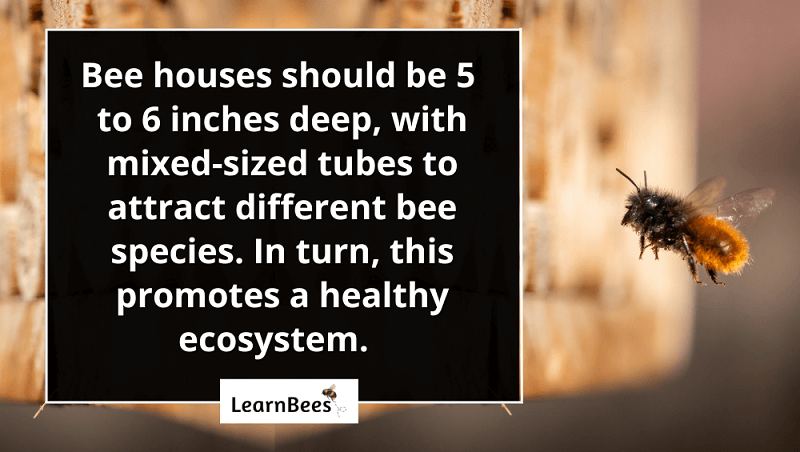
In this section, we’ll cover the following:
- When should you hang a mason bee house?
- How high should a mason bee house be placed?
- What direction should a mason bee house face?
But let’s start at the beginning.
You’ll need to use a mason bee house that’s at least five to six inches long. This gives the bees plenty of length to lay multiple eggs.
You can buy a pre-made mason bee house or make one yourself using a can or something similar.
From there, you’ll want to add tunnels of various sizes.
We recommend using paper straws because they’re breathable, which helps prevent mold and moisture.
Paper straws are also affordable and biodegradable. This means they’re easy to replace each year once the mason bees are finished with them. As a result, this helps maintain a clean environment by reducing the spread of pests and diseases.
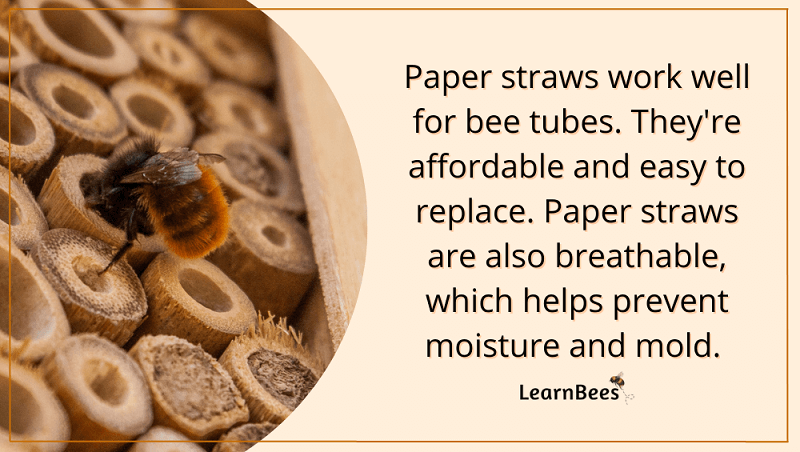
Now, this is important:
Using the same-sized straws isn’t ideal because it promotes a monoculture.
In other words, same-sized mason bee tunnels attract a limited number of bee species. In turn, this can lead to a breeding ground for pests and diseases.
Take bumble bees, for example.
Scientists have discovered that crowding bumble colonies together increases their chances of contracting Nosema bombi, which is a fungus that severely weakens their hives.(1, 2)
You see, in their natural environment, bumble bees build nests that are widely spaced from other bumble bee colonies. This reduces the spread of pathogens and parasites while also limiting competition.
This is how a healthy ecosystem works.
In nature, we see various species living among various plants. Carpenter bees may live next to mason bees, who live next to mud dauber wasps, and so on. This acts as a checks and balances system that contributes to a healthy ecosystem.
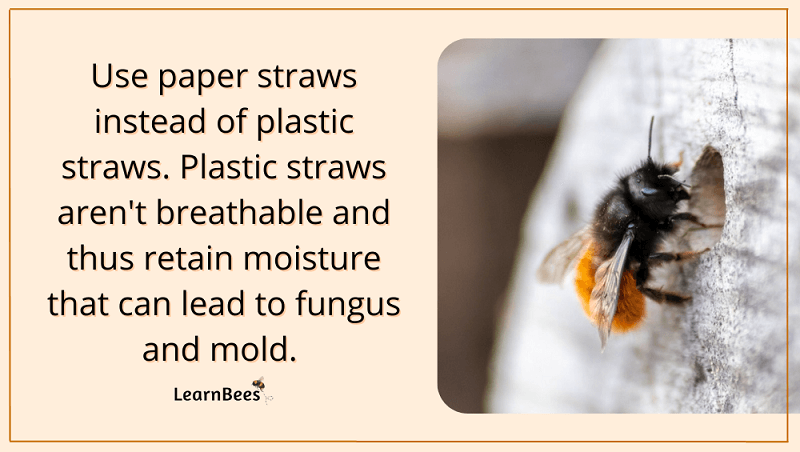
So, in a nutshell:
Adding paper straws with mixed sizes promotes the same diversity found in nature.
Multiple sizes attract multiple insect species. This way, disease transmission is minimal, and you strike more of a balance that mimics nature.
Here are three tunnel sizes you should use:
Paper straws can be easily cut to the appropriate length to fit inside your mason bee housing.
When placing the straws inside the mason bee house, pack them tightly enough so they don’t get dislodged in the wind.
Additionally, sometimes mason bees accidentally pull straws out of the bee house. This occurs when the bee flies out of the tunnel while her abdomen is still slightly wedged in.
Don’t worry. This doesn’t hurt the bee.
However, packing the straws tightly will prevent you from having to pick them up off the ground if this happens.
When Should You Hang Mason Bee Housing?

As a rule of thumb:
Mason bee houses should be hung by the early spring, as the flowers start to bloom.
More importantly?
Mason bee houses should be hung within a couple of hundred feet of blooming flowers. Mason bees don’t usually fly long distances to find nectar and pollen.
And remember:
Bees rely on nectar and pollen for food. If there aren’t blooming flowers, then the bees cannot eat. Planting native flowers will go a long way in helping your local pollinators.
How High Should Mason Bee Housing Be Placed?
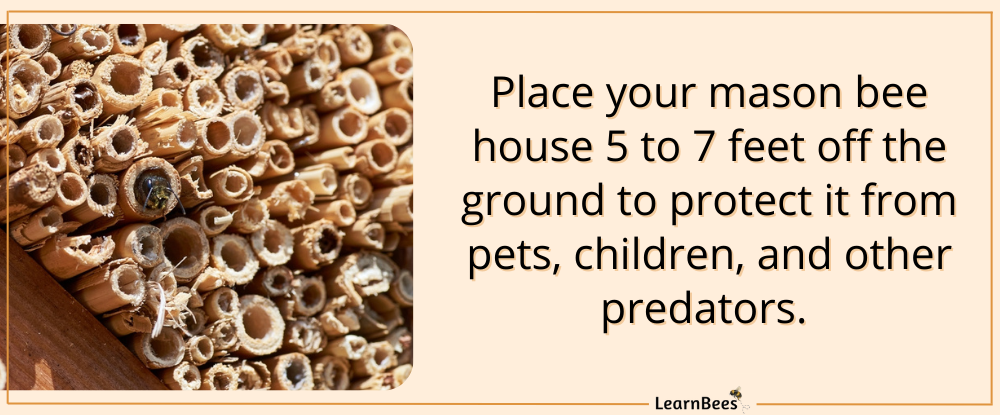
Place your mason bee house five to seven feet off the ground. This is a good height because it allows you to observe the bees while protecting them from pets and small children.
We also recommend mounting the house directly to a sturdy surface, such as a house or shed. This helps prevent damage from high winds or rain.
Lastly, there needs to be enough space around the bee house for the bees to fly in and out without any obstruction from shrubs or manmade structures. This will ensure your bees can find food and return home without trouble.
What Direction Should Mason Bee Housing Face?
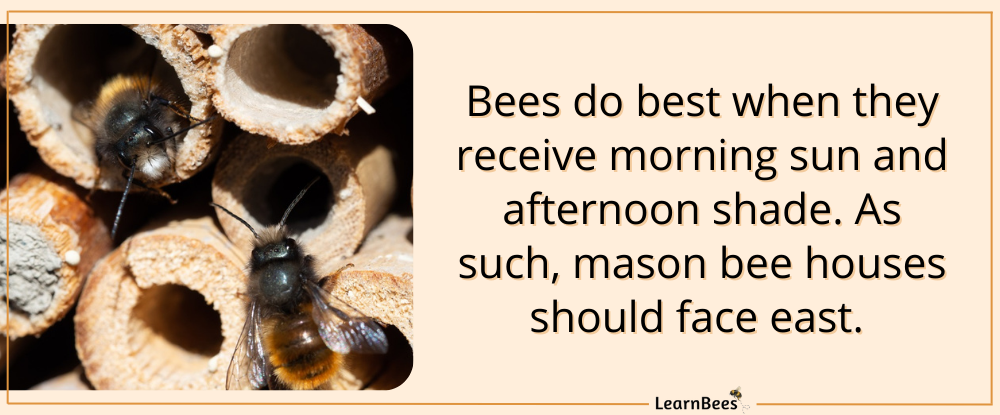
Mason bee houses should be facing east, where they can get full morning sun and afternoon shade.
Avoid placing your mason bee housing in full sun.
Why?
Because wild mason bees that are left to their own devices typically build nests in partly shaded areas. After all, they nest in tree cavities and hollow stems that have tree canopies to shade them.
That said, mason bees usually don’t select deep shade.
Instead, morning sun and afternoon shade is ideal. It’s enough to warm them up in the morning so they can start foraging. But it also gives them reprieve from the burning-hot afternoon sun.
FAQs on Mason Bee Housing
- Do you have to clean out mason bee houses?
- When do I install a mason bee house?
- What should the size of the hole be for a mason bee house?
- How far off the ground should a bee house be?
- What are two potential problems with bee hotels?
- What do you do with a mason bee house in the winter?
- Should a bee house be in full sun?
- What time of year are mason bees most active?
- Do mason bees go in their houses at night?
- Will a wasp nest in a mason bee house?
- How do you attract mason bees to a mason bee house?
- Do mason bees return to old nests?
Do you have to clean out mason bee houses?
“How do you maintain a mason bee house year after year?” is a common question.
The answer is yes; mason bee houses need to be cleaned. If you’re using paper straws, then you can simply replace them with new ones each year. Paper straws are affordable and come in large packs of 100 or more.
Additionally, paper straws work well because you can replace them instead of cleaning them with bleach or other chemicals.
Here’s the critical part:
Don’t replace the tubes while the bees are still in them.
Sometimes mason bees will reuse old tunnels, and you don’t want to throw away a cocoon accidentally. Using a flashlight will make it easier to spot the old tubes from the used ones.
If you’re using wooden tubes, then you should clean them at least every other year.
You can clean them by soaking them in a bleach-water mixture with a 1:2 ratio (one part bleach to two parts water). Keep them submerged in the bleach water for at least 15 minutes.
Next, rinse them well before scrubbing them with soap and water. Ensure you’re getting rid of all the bleach by rinsing them thoroughly. Let them dry fully before placing them back inside the mason bee housing.
Note:
Sometimes chalkbrood spores will remain behind even if the mason bee tubes are cleaned this way. Chalkbrood is a disease that’s fatal to bees. The only way to protect against chalkbrood spores is to replace the tubes annually.
—> Go back to the FAQs on mason bee housing
More to Explore:
When do I install a mason bee house?
You should install your mason bee house once spring flowers bloom.
—> Go back to the FAQs on mason bee housing
More to Explore:
What should the size of the hole be for a mason bee house?
The holes should be between 4-8mm in diameter. You want to pick tunnels with various sizes, as different types of bees prefer different sizes.
Additionally, mixing sizes prevents a monoculture, which can be unhealthy for bee populations.
—> Go back to the FAQs on mason bee housing
More to Explore:
How far off the ground should a bee house be?
Place your mason bee housing at least five to seven feet off the ground.
—> Go back to the FAQs on mason bee housing
More to Explore:
What are two potential problems with bee hotels?
The main problem with bee hotels is that they can spread diseases if not replaced or cleaned. That’s why we recommend using paper straws that can be easily replaced yearly. Paper straws are affordable and come in different sizes, which is ideal for attracting many species of mason bees.
The second problem with bee hotels is that people are encouraged to buy bees online.
Repeat after me:
You should never buy bees online.
It’s better to attract native bees that are local to your area. Mason bees that are purchased online aren’t adapted to your local climate.
What’s worse, shipping mason bees across the country often ships pests and infections with them, which can disrupt the balance of your local ecosystem.
—> Go back to the FAQs on mason bee housing
More to Explore:
What do you do with a mason bee house in the winter?
In most cases, we recommend leaving your mason bee house outside during the winter so the bees can maintain their natural schedule. When spring hits, they’ll decide for themselves when it’s time to emerge.
If you live in a wet climate like the Pacific Northwest, try to place your bee house where it’s sheltered from the rain. This could mean under a roof eave or awning, for example. Having a shelter will prevent the bee house from growing mold or fungus.
—> Go back to the FAQs on mason bee housing
More to Explore:
Should a bee house be in full sun? Where is the best place to hang a mason bee house?
The best place to install your bee house is in the morning sun with afternoon shade. Full sun or full shade is less than ideal.
—> Go back to the FAQs on mason bee housing
More to Explore:
What time of year are mason bees most active?
Mason bees have the highest amount of activity during the spring and summer.
—> Go back to the FAQs on mason bee housing
More to Explore:
- Ground Bees: Are They a Threat to Your Yard?
- Wasps vs. Honeybees: Are They Different?
- Do Bumble Bees Bite?
Do mason bees go in their houses at night?
Yes, mason bees will return to their tubes to rest at night.
—> Go back to the FAQs on mason bee housing
More to Explore:
Will a wasp nest in a mason bee house?
Yes, certain solitary wasps will nest in bee houses and lay eggs, similar to the way tube-nesting bees do. You shouldn’t be concerned if this is the case.
Wasps are beneficial creatures that play a role in pollination. Having different insects nesting in the area helps create a more balanced ecosystem.
—> Go back to the FAQs on mason bee housing
More to Explore:
- Do Carpenter Bees Pollinate?
- How Long Do Bumble Bees Live?
- Honeybees vs. Bumblebees: How Do They Compare?
How do you attract mason bees to a mason bee house?
The best way to attract mason bees is to plant native flowers, provide a local water source, and avoid using pesticides. These three things shouldn’t be underestimated.
From there, adding a mason bee house will help seal the deal for attracting native bees to your garden.
—> Go back to the FAQs on mason bee housing
More to Explore:
- Do Queen Bees Eat Honey?
- Are Worker Bees Male or Female?
- Queen Bee Versus Worker Bees – How Do They Compare?
Do mason bees return to old nests?
Female mason bees have a short lifespan, so the same mason bee never returns to the same nest year after year.
That said, other mason bees and native bees will reuse the bee hotel yearly. Just ensure that you replace the paper straws or clean the wood tunnels once the bees are done nesting.
